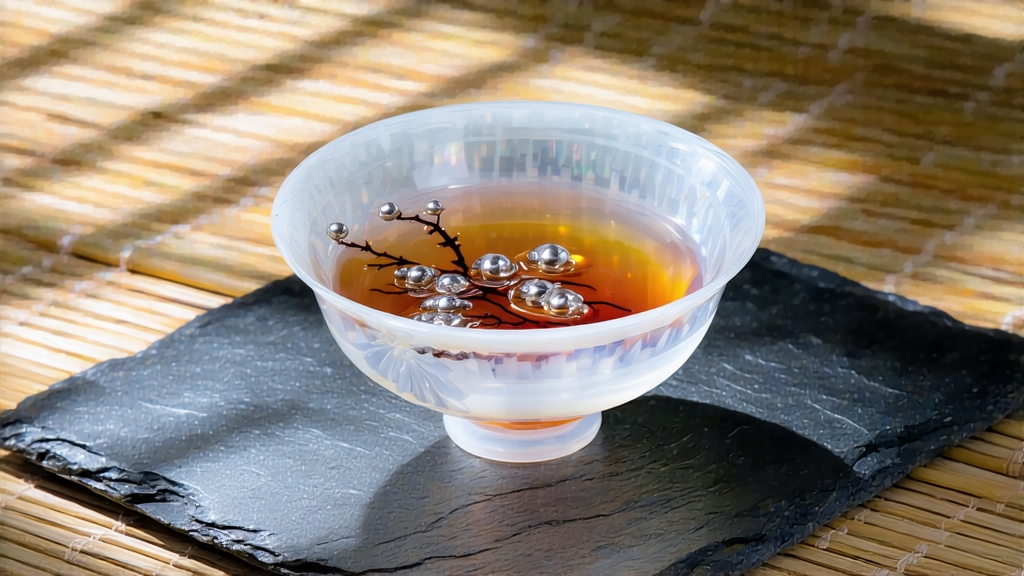
To most Western drinkers “white tea” is a color-coded mystery, a pale cup that tastes like scented water. Yet within China’s pantheon of teas, white tea is a full chapter, and Bai Hao Yin Zhen—“Silver Needle” or simply “White Down”—is its opening sentence, written in the language of spring mist and newborn buds. This essay invites you to linger over that sentence until you hear the whole story: how a single bud, plucked before the world is fully awake, can carry within it the geology of Fujian’s granite mountains, the ethics of patience, and the perfume of a quiet afternoon seven centuries ago.
-
A bud that outran history
The first verifiable record of white tea appears in the Song dynasty treatise Da Guan Cha Lun (1107), where the emperor’s tea garden in Fujian’s Beiyuan offered “silver frost buds” as tribute. Those buds were steamed, pressed into cakes, and ground to powder—still a far cry from today’s loose-leaf Silver Needle. The modern form emerged during the late Qing, when export merchants around Fuding realized that sun-dried buds, shipped quickly to the treaty ports, fetched higher prices than the customary compressed bricks. By 1891 Silver Needle was sailing to Hong Kong, then to London, where it was displayed like jewelry under glass domes. The tea survived wars, revolutions, and the collapse of imperial trade, but it never surrendered its aristocratic reticence; even now, one kilogram needs roughly thirty-eight thousand buds, all picked within a two-week window in late March. -
Geography as terroir
Authentic Silver Needle is born in two coastal counties of Fujian: Fuding and Zhenghe. Fuding sits on a granite bed; its red sandy soil drains quickly, forcing the tea bushes (predominantly Fuding Da Bai cultivar) to send sugars to the very tips of their shoots. Zhenghe, higher and more humid, sits on purple shale; the same cultivar grows slower there, yielding buds that are slightly slimmer but richer in amino acids. Between the two micro-terroirs lies a third, lesser-known zone—Jianyang—where the hybrid “Small White” bush produces needles with a faint almond note. Connoisseurs treat these three origins like Burgundy crus: same grape, different parish bells. -
The craft of doing almost nothing
White tea’s motto is wu wei—action through inaction. After picking, the buds are spread on bamboo trays only two centimeters thick so that each needle rests in a single, airy layer. For the next thirty-six to forty-eight hours they are left under a roofed courtyard where mountain breeze, rather than machines, carries away moisture. The wither is paused at sunset when workers gently rake the buds into thicker piles to conserve heat, then re-spread them at dawn. No rolling, no pan-firing, no shaking; the cell walls break open by their own enzymatic weight, oxidizing only 5–10 %. When the bud’s moisture drops to 8 %, a final twenty-minute bake at 60 °C locks in the fragrance without caramelizing sugars. The result is a needle still clad in its pearl-white down, smelling like fresh rain on hay. -
A leaf that ages like wine
Unlike green tea, Silver Needle improves—and changes—over decades. Enzymes continue a slow oxidative dance, while native yeasts and the bacterium Aspergillus chevalieri generate notes of marzipan, dried persimmon, and antique camphor. A 2012 study at Fujian Agriculture University found that twenty-year-old Silver Needle contains twice the syringic acid of its younger self, explaining the deeper, honeyed finish. Storage rules are simple: breathable paper, no plastic, stable 20–30 °C, and 50–60 % humidity. In Hong Kong’s antique tea shops, a 1997 cake now sells for more than silver bullion by weight. -
Brewing: the art of restraint
Western manuals often recommend 80 °C for three minutes, a formula that flattens the tea into polite boredom. The Chinese gongfu approach treats Silver Needle like a shy violinist: give it space, and it will rise to concert pitch.
Equipment: 120 ml porcelain gaiwan or a tall glass cha zhong; filtered water low in minerals; a kettle that can hold